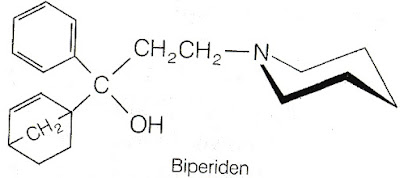CHOLINERGIC BLOCKING AGENTS CHOLINERGIC RECEPTOR ANTAGONISTS (or) ANTI SPASMODICS
The anti cholinergic drugs are agents that inhibit the effect on Acetyl choline (Ach) released from post ganglionic parasympathetic nerve endings. They block muscarinic action of Ach including smooth muscle contraction and exocrine gland secretion. Because of the ability to relax smooth muscles, they are also referred as antispasmodics. The cholinergic blocking agents that have high affinity to the receptors may decrease the no. of available free receptors and the efficiency of the endogenous neuro transmitter like Ach. Anti muscarinic drugs act by competitive antagonism of Ach binding to muscarinic receptors.
The anti cholinergic drugs are agents that inhibit the effect on Acetyl choline (Ach) released from post ganglionic parasympathetic nerve endings. They block muscarinic action of Ach including smooth muscle contraction and exocrine gland secretion. Because of the ability to relax smooth muscles, they are also referred as antispasmodics. The cholinergic blocking agents that have high affinity to the receptors may decrease the no. of available free receptors and the efficiency of the endogenous neuro transmitter like Ach. Anti muscarinic drugs act by competitive antagonism of Ach binding to muscarinic receptors.
CLASSIFICATION
1.Solanaceous alkaloids and Analogues - Atropine Sulfate, Hyoscyamine sulfate, Scopalamine HBr, Homatropine HBr, Ipratropium bromide.
2. Amino alcohol esters - Cyclopentolate. HCl, Clidinium bromide, Dicyclomine HCl, Glycopyrrolate, Methanthelin bromide, Propanthelin bromide, Mepenzolate.
3. Amino Alcohols- Biperidine HCl, Procyclidine HCl
4. Amino alcohol ethers Benztropine mesylate, Orphenadrine
5. Amino amide - Tropicamide, Isopropamide iodide
6. Miscellaneous - ethopropazine.
Atropine
Clidinium bromide
 Biperiden
Biperiden 
SAR FOR CHOLINERGIC BLOCKING AGENTS

- Anti cholinergic compounds has some structural similarity to acetyl choline but contain additional substituents which enhance their binding to cholinergic receptors.
- R- may be hydroxy alkyl, alkyl, cycloalkyl or heterocyclic group for good anti cholinergic activity.
- The nitrogen is tertiary atom which contains alkyl group not larger than butyl for effective antagonist activity.
- The acyl group is always larger than acyl group in acetyl choline for good activity.
Hydrophobic substituents increase the affinity to binding the receptors and have good antagonist property. - The presence of free hydroxyl or carbamide is also important for hydrogen bonding with receptor.
- Naturally occurring l-hyocyamine is more active than d-isomer.
MECHANISM OF ACTION
The cholinergic blocking agents are competitively inhibit the cholinergic receptors and prevent the binding of acetyl choline to the receptors due to the size of acyl group through ‘umbrella effect’.
The large group (alkyl or aryl) present in cholinergic blocking agents increase the affinity of the blocking agent and also block the approach of acetyl choline to the receptor.
